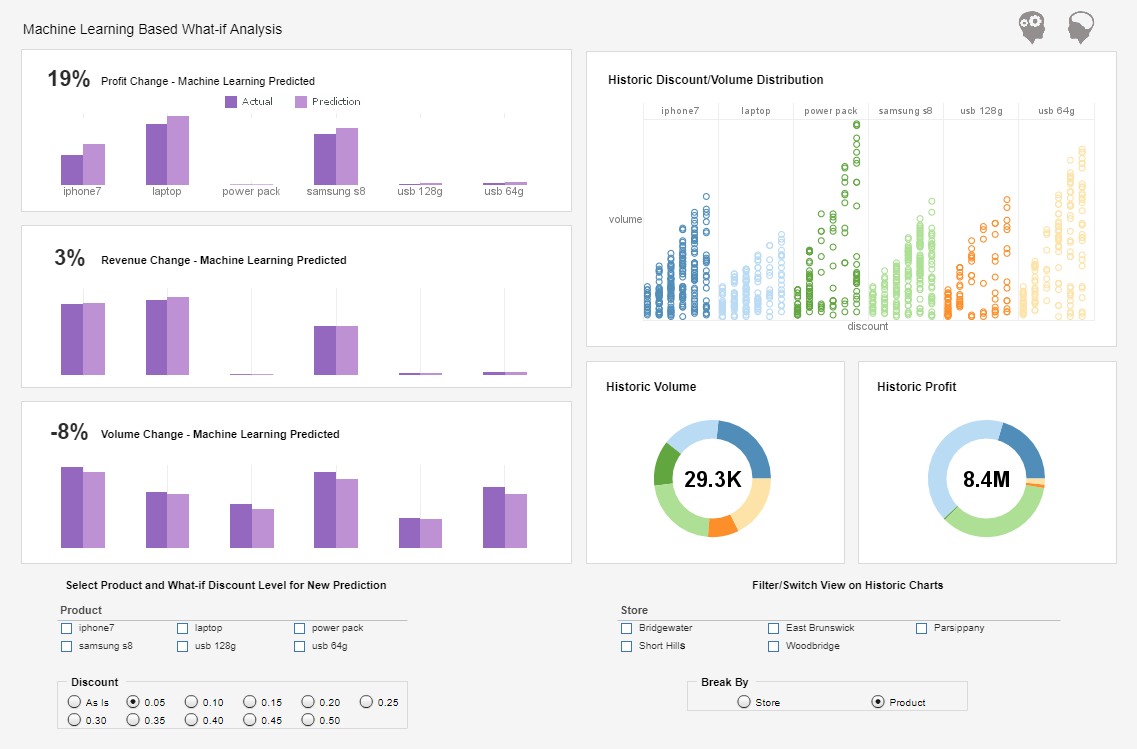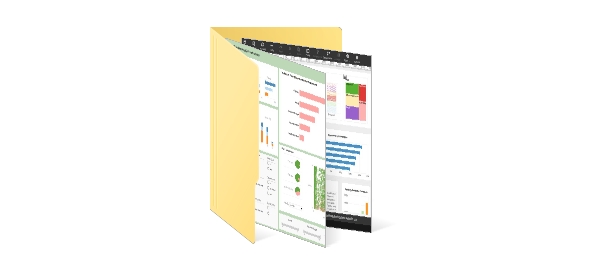Why BI Programs Do Not Achieve Full Success
This is the transcript of a Webinar hosted by InetSoft on the topic of "The Importance of Having a BI Strategy". The presenter is Mark Flaherty, CMO at InetSoft.
Mark Flaherty (MF): So first off, let's talk a little bit about what’s going on with BI programs in a lot of customer situations, because from my experience many of these BI programs have not really achieved full success. They don’t live up to their potential and some of them fail outright. What have been some of our observations as to why that happens in the first place?
Well I think the principle reason that business intelligence deployments don’t succeed is simply because the organizations frankly don’t have a plan. They don’t have a strategic plan for BI in the organization. Typically they have acquired a specific product for a specific need. Or it was the bright shiny object they saw when walking around the trade show floor. Or maybe it was from the most recent phone call they got from someone in the business who had a very specific problem to solve.
But business intelligence in most organizations ought to be thought of as a strategic opportunity and something that needs to be thought of broadly. That being said, I do think there are good reasons why you get started departmentally.
There may be a specific use case you have to solve, which is fine. But at the end you don’t want to be caught with just an architecture diagram as your BI strategy, and you certainly have to think about that holistically for your enterprise.
A Picture Of Your BI Architecture Is Not A Strategy
Absolutely a picture of your BI architecture is not a strategy. Whether it's a architectural diagram or whether it's an organizational structure, pictures don’t tell the story. What really tells the story is interaction with the business users, understanding what the broader needs of the organization are and understanding that each project is a particular innovation, a particular subset of those needs and understanding how the value of one project can be enhanced enormously, if a lot of it is re-used in the next project. That’s true whether it’s the metadata, or skills, or best practices. BI has a perennial opportunity within most enterprises.
The other thing I always keep coming back to is the basics of business intelligence. What you can't measure, you can't manage. It's as simple as that. So one thing I am telling all of our customers is make sure that you have measures. If you don’t do a whole lot in terms of developing a BI strategy, do at least three basic things: get together with your business stakeholders and talk about, first of all, what’s the information you need. Do you have all the data you need to make decisions to be successful? That’s number one. The number two question is the frequency, the timeliness of the information. Do you get the information when you actually need it.
And the third one is, is the information you are getting, do you actually trust it? That’s a huge one, because as you know, more and more of the studies we see are about “do business executives trust the information they are getting from their IT organization.” By and large the answer is “no.” Often a majority of the respondents say “no, frankly I don’t have confidence.” So this is a really key thing for the metrics that you want to manage your corporate performance with.
Whether that’s being able to effectively demonstrate the providence of the data, where did we get it, how do we do the computations that went into these charts? While we can measure lots of data, how often do we respond in a timely way to a change in the data, an uptick in customer complaints, for instance, in order to improve customer satisfaction.
Building confidence in a business intelligence (BI) solution is crucial for ensuring that executives and decision-makers trust the insights and recommendations derived from the data. Confidence in a BI solution is built upon several key factors, including data quality, accuracy, relevance, usability, and transparency. By addressing these factors and implementing best practices in BI development and deployment, organizations can establish trust in their BI solutions and empower executives to make data-driven decisions with confidence.
First and foremost, ensuring data quality and accuracy is essential for building confidence in a BI solution. Executives rely on BI systems to provide accurate and reliable information for strategic decision-making, so it's imperative that the data feeding into the BI solution is clean, consistent, and trustworthy. This involves implementing robust data governance processes, data validation checks, and data cleansing procedures to identify and rectify errors, inconsistencies, and discrepancies in the data. By maintaining high standards of data quality, organizations can instill confidence in the integrity of their BI solutions and the insights derived from them.
Additionally, relevance and usability are key considerations in building confidence in a BI solution. Executives need access to actionable insights that are relevant to their roles and responsibilities, presented in a format that is intuitive and easy to understand. This requires close collaboration between BI developers and business stakeholders to understand their specific requirements and design dashboards, reports, and visualizations that meet their needs. By tailoring the BI solution to the unique needs of the organization and its users, organizations can ensure that executives have access to the information they need to make informed decisions confidently.
Transparency is another critical factor in building confidence in a BI solution. Executives need to understand how the data is collected, processed, and analyzed to generate insights and recommendations. This requires clear documentation of data sources, methodologies, assumptions, and limitations, as well as transparent communication of any uncertainties or risks associated with the analysis. By providing transparency into the analytical process and the underlying data, organizations can enhance trust in the BI solution and foster a culture of data-driven decision-making.
Furthermore, organizations can build confidence in their BI solutions by demonstrating the value of data-driven insights through tangible results and outcomes. This involves tracking key performance indicators (KPIs) and metrics to measure the impact of BI initiatives on business outcomes such as revenue growth, cost savings, customer satisfaction, and operational efficiency. By showcasing the positive impact of data-driven decisions on the organization's bottom line, executives will be more likely to trust and invest in the BI solution as a strategic asset.
What Is the Appropriate Drill-down Capability for C-level Executives?
The drill-down capability for C-level executives in their dashboards should be carefully tailored to balance the need for detailed insights with the requirement for simplicity and efficiency. While C-level executives require access to comprehensive and accurate information to make informed decisions, their dashboards should prioritize high-level insights and key performance indicators (KPIs) rather than delving into granular details.
Here are some considerations for determining the appropriate level of drill-down capability for C-level executives:
-
Focus on Strategic Metrics: C-level executives are primarily concerned with strategic decision-making and setting the direction for the organization. Therefore, their dashboards should emphasize high-level strategic metrics that align with the organization's goals and priorities. These metrics may include overall revenue, market share, profitability, customer satisfaction, and key operational KPIs.
-
Provide Contextual Insights: While C-level executives may occasionally need to drill down into specific data points to understand the underlying factors driving performance, their dashboards should provide contextual insights and trends to facilitate decision-making. Visualizations such as trend lines, comparisons to historical data, and benchmarking against industry peers can help executives understand the broader context of the data and identify areas for improvement.
-
Limit Drill-down Levels: To maintain simplicity and clarity, C-level dashboards should limit the number of drill-down levels available to executives. Rather than allowing unlimited drill-downs into granular data, dashboards can provide predefined levels of detail that align with the executives' information needs. For example, executives may have the ability to drill down from regional sales performance to individual product categories, but not to individual sales transactions.
-
Customize for Individual Preferences: Different executives may have varying information needs and preferences when it comes to data analysis. Therefore, dashboards should allow for customization to accommodate individual preferences while maintaining consistency and coherence across the organization. Executives should have the flexibility to personalize their dashboards by selecting the KPIs, metrics, and visualizations that are most relevant to their roles and responsibilities.
-
Enable Ad Hoc Analysis: While C-level dashboards should provide predefined insights and metrics, they should also support ad hoc analysis and exploration for executives who require deeper insights into specific areas of interest. Dashboards can incorporate interactive features such as filters, search functionality, and drill-through capabilities to enable executives to explore the data in more detail as needed.
-
Promote Data Literacy: To maximize the effectiveness of C-level dashboards, organizations should invest in promoting data literacy among executives and providing training on how to interpret and use the data effectively. Executives should understand the limitations of the data, how it is collected and processed, and how to interpret the insights derived from it to inform decision-making.
More Articles About BI Programs
Captivating Visualizations that Communicate for BA's - Since InetSoft's StyleBI is web-based, communicating the state of an organization to users in many locations is now easier than ever. The user friendly reporting engine enables the easy generation of pixel perfect reports that help define and monitor the metrics and status of an enterprise...
Features of a Good Report Designer - Selecting the right report designer software is crucial for creating impactful and insightful reports. Here are the key product features to consider when evaluating report designer applications: Intuitive Interface: The software should have a user-friendly interface that allows for easy navigation and intuitive report creation. Drag-and-drop functionality and a clean layout contribute to a seamless user experience...
How to Make a Wind Rose Chart in InetSoft - There is no built-in chart type for a wind rose; however, since a wind rose is essentially a stacked bar chart bent into a circle, it is possible to obtain this display by applying a small script to an existing stacked bar chart. Begin by importing the data set into a Data Worksheet. The sample data we use here is from Iowa Environmental Mesonet and has this form...
Use Cases of Big Data in Biotechnology - We open the list with the obvious choice because genomics is the brand ambassador of big data in biotechnology. Genomics is the science of human genes, so it's obvious why big data is needed here. Genome sequencing is getting faster every day, but it still takes years to uncover the entire genome. Farmers are struggling to adjust to the growing impact of climate change, so they started using big data analytics as the new means of data interpretation. They can rely on GPS and weather forecasts to develop so-called precision farming, while GMO enables agriculture companies to improve their products...
What Is Graphicacy? - And there is a concept of, we call it, I think graphicacy is what how Howard Spielman would call it. Graphicacy is a term that refers to the ability to understand and interpret visual information, particularly in the context of graphs, charts, maps, and other graphical representations of data. It encompasses the skills and cognitive processes involved in comprehending visual stimuli, extracting meaning from visual representations, and making inferences or decisions based on visual information. Similar to literacy, which pertains to the ability to read and comprehend written language, graphicacy focuses on the ability to "read" and interpret visual language effectively...


